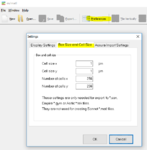Puppet123
Full Member level 6
Hello,
I have Momentum slm and ltd files that define a substrate in a process.
Is there an easy way to convert these into an ASITIC tek file, I want to design some passives in ASITIC but dont have the tek file.
Thanks.
I have Momentum slm and ltd files that define a substrate in a process.
Is there an easy way to convert these into an ASITIC tek file, I want to design some passives in ASITIC but dont have the tek file.
Thanks.
